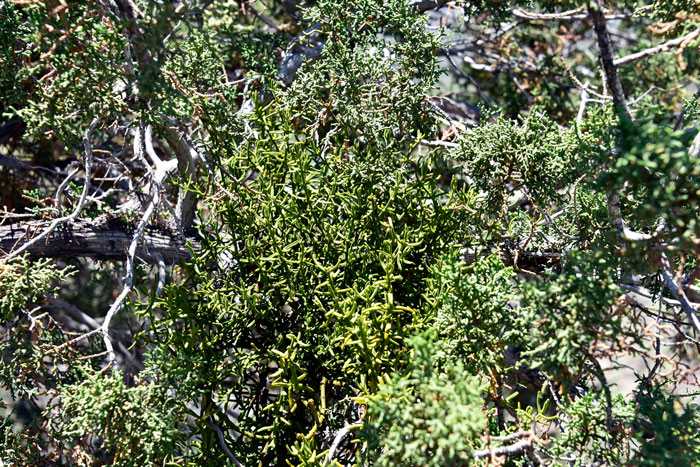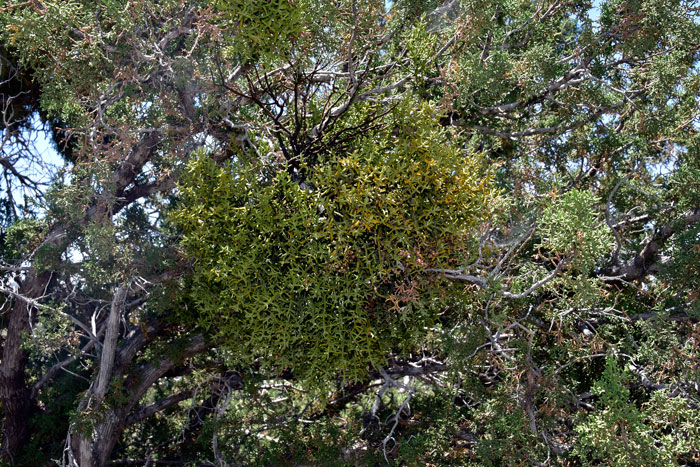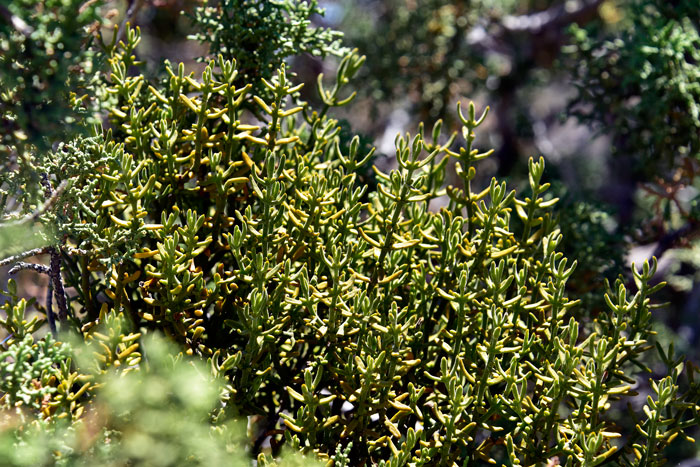Phoradendron juniperinum, Juniper Mistletoe



Scientific Name: Phoradendron juniperinum
Common Name: Juniper Mistletoe
Also Called: Mistletoe
Family: Santalaceae or Sandalwood Family
Synonyms: (Phoradendron juniperinum var. juniperinum, Phoradendron juniperinum var. ligatum, Phoradendron ligatum)
Status: Native
Duration: Perennial
Size: Up to 15 inches or so.
Growth Form: Shrub, subshrub; mostly erect, base is woody (suffrutescent), glaucous.
Leaves: Green; leaves scale-like.
Flower Color: Green; inconspicuous; both staminate and pistillate flowers; fruit pinkish-white also glabrous.
Flowering Season: June to July.
Elevation: 4,000 to 7,000 feet; 5,500 to 8,500 in California.
Habitat Preferences: Pinyon-juniper communities; parasitic on several species of Juniper; rarely on Pinyon (Piñon) Pine (Pinus edulis).
Recorded Range: Phoradendron juniperinum or Juniper Mistletoe is found primarily in the southwestern United States in AZ, CA, CO, NM, NV, OR, TX, UT. It is also native to Baja California and northern Mexico. In Arizona it is found throughout the state with few or no records in Yuma and LaPaz counties.
North America & US County Distribution Map for Phoradendron juniperinum.
U.S. Weed Information: No information available.
Invasive/Noxious Weed Information: No information available.
Wetland Indicator: No information available.
Threatened/Endangered Information: No information available.
Prior to acknowledgment of genetic studies by the Angiosperm Phylogeny Group, Phoradendron was included in the Viscaceae family. Before that it was placed in its own family, the Phoradendron family. Some botanists still include this species in the Viscaceae family.
In the Southwestern United States, Arizona and California each have 7 species of Phoradendron, Nevada has 2 species, New Mexico and Texas each have 8 species and Utah has 2 species. All data is approximate and subject to taxonomic changes.
Comments: Juniper Mistletoe, Phoradendron juniperinum is a high desert and uplands species found in pinyon-juniper communities and is parasitic on several species of Junipers.
Phoradendron juniperinum or Juniper Mistletoe has been used for a variety of purposes including food and as a drug for several ailments by South American indigenous peoples.
Acoma Food, Starvation Food, Berries eaten when other foods became scarce.
Havasupai Food, Unspecified, Plant pounded and boiled for food.
Hopi Drug, Gastrointestinal Aid, Plant used as 'medicine for the stomach.'
Hopi Drug, Witchcraft Medicine, Plant used as 'medicine for the stomach and bad medicine of wizards.'
Keres, Western Drug, Antidiarrheal, Crushed plant given to children for diarrhea.
Laguna Food, Starvation Food, Berries eaten when other foods became scarce.
Navajo Drug, Dermatological Aid, Plant used for warts.
Tewa Drug, Gastrointestinal Aid, Infusion of pulverized plant taken for 'chill in the stomach.'
Zuni Drug, Emetic, Infusion of whole plant taken as an emetic for stomachaches.
Zuni Drug, Gynecological Aid, Compound infusion of plant taken to promote muscular relaxation at birth.
Zuni Drug, Gynecological Aid, Compound infusion of plant taken to promote muscular relaxation at birth.
Simple or compound infusion of twigs taken after childbirth to stop blood flow.
See ethno-botanical uses at Native American Ethnobotany, University of Michigan, Dearborn.

